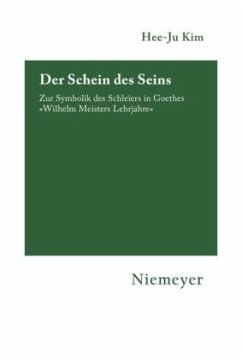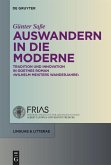In his works Goethe not only creates symbols. He also creates heroes who create their own symbols. The »Lehrjahre« is a case in point. Here the protagonist invents the world, both consciously and unconsciously, as a system of signs enabling him to empower himself of the outer world as a product of his inner world. This is illustrated by a semiotic analysis of the symbolism of the veil. This symbolic ploy represents a consistent reflection of the crisis-ridden formation of identity in the initially narcissistic hero, Wilhem Meister, and traces the way it evolves through the subsequent stages of his career. At the same time, it also pinpoints the interplay between ethos and eros.
Die Studie untersucht das facettenreiche Handlungsgefüge der »Lehrjahre« und das ihm inhärente Motivgeflecht im Hinblick auf den psychischen Entwicklungsprozeß des Protagonisten. Im Zentrum der Analyse steht die Schleiersymbolik, die mit der für Wilhelm Meisters Identitätsbildung fundamentalen Vater-Sohn-Problematik verquickt ist. Sie speist sich aus einer Fülle von Kleidungsstücken, personellen Konstellationen, ästhetischen Bildern und literarischen Szenen. Gezeigt wird im einzelnen, wie sie den ganzen Roman durchzieht, alle entscheidenden Stationen der krisenhaften Identitätsgenese kodiert und den Konfliktzusammenhang von narzißtischen Identitätsentwürfen und realitätsbezogenen Identitätskrisen strukturiert und reflektiert. Besondere Beachtung erfährt dabei das Widerspiel von Ethos und Eros, das der Roman im Medium der Schleiersymbolik psychologisch entfaltet, um im Spannungsfeld von Schein und Vorschein dem lebensgeschichtlichen Wechselspiel von Innenwelt und Außenwelt Ausdruck und Gestalt zu verleihen.
Die Arbeit wurde mit dem Jahrespreis 2003 der Wissenschaftlichen Gesellschaft Freiburg ausgezeichnet.
Die Studie untersucht das facettenreiche Handlungsgefüge der »Lehrjahre« und das ihm inhärente Motivgeflecht im Hinblick auf den psychischen Entwicklungsprozeß des Protagonisten. Im Zentrum der Analyse steht die Schleiersymbolik, die mit der für Wilhelm Meisters Identitätsbildung fundamentalen Vater-Sohn-Problematik verquickt ist. Sie speist sich aus einer Fülle von Kleidungsstücken, personellen Konstellationen, ästhetischen Bildern und literarischen Szenen. Gezeigt wird im einzelnen, wie sie den ganzen Roman durchzieht, alle entscheidenden Stationen der krisenhaften Identitätsgenese kodiert und den Konfliktzusammenhang von narzißtischen Identitätsentwürfen und realitätsbezogenen Identitätskrisen strukturiert und reflektiert. Besondere Beachtung erfährt dabei das Widerspiel von Ethos und Eros, das der Roman im Medium der Schleiersymbolik psychologisch entfaltet, um im Spannungsfeld von Schein und Vorschein dem lebensgeschichtlichen Wechselspiel von Innenwelt und Außenwelt Ausdruck und Gestalt zu verleihen.
Die Arbeit wurde mit dem Jahrespreis 2003 der Wissenschaftlichen Gesellschaft Freiburg ausgezeichnet.








